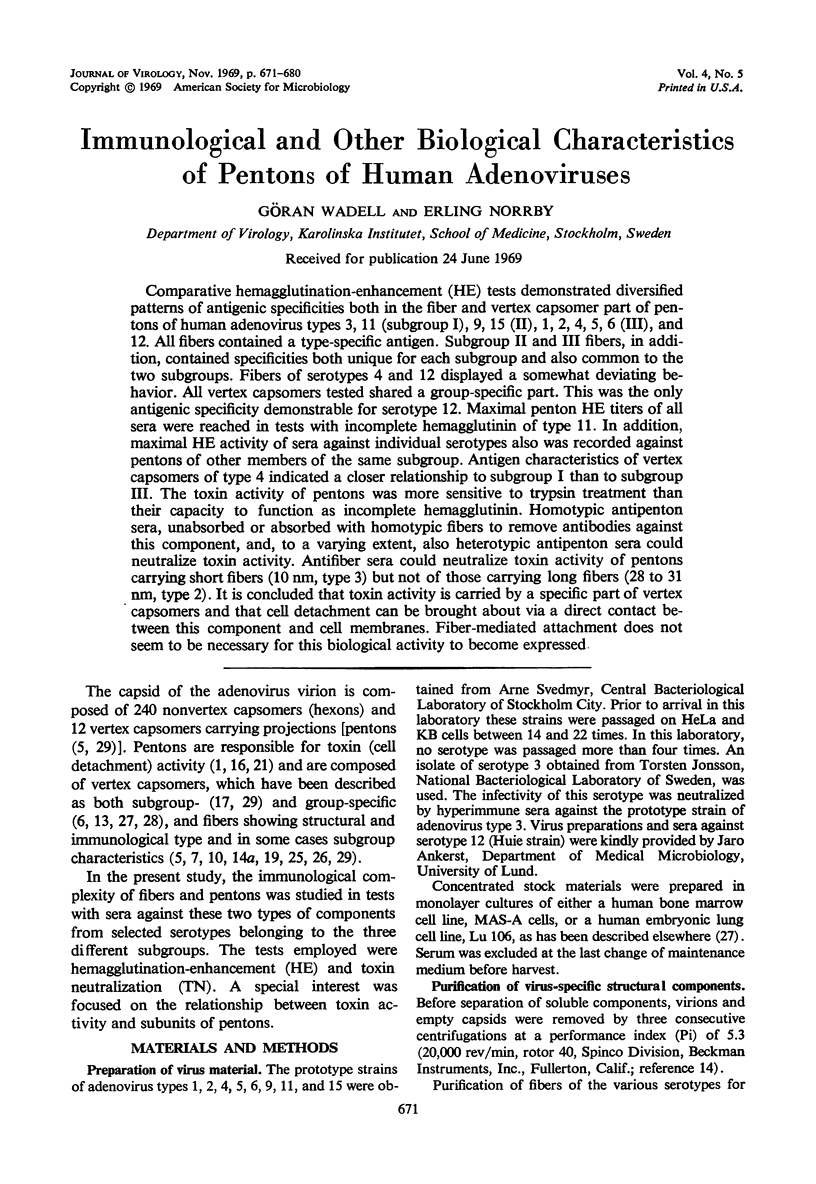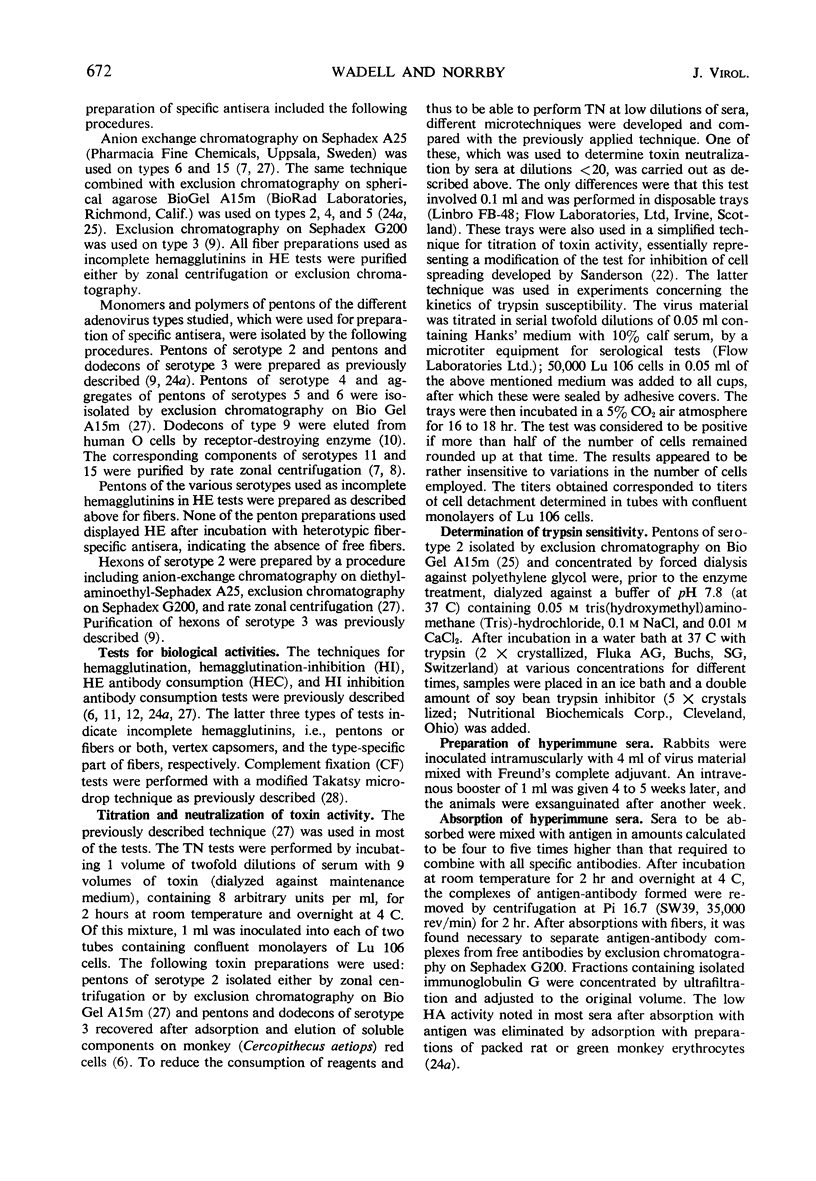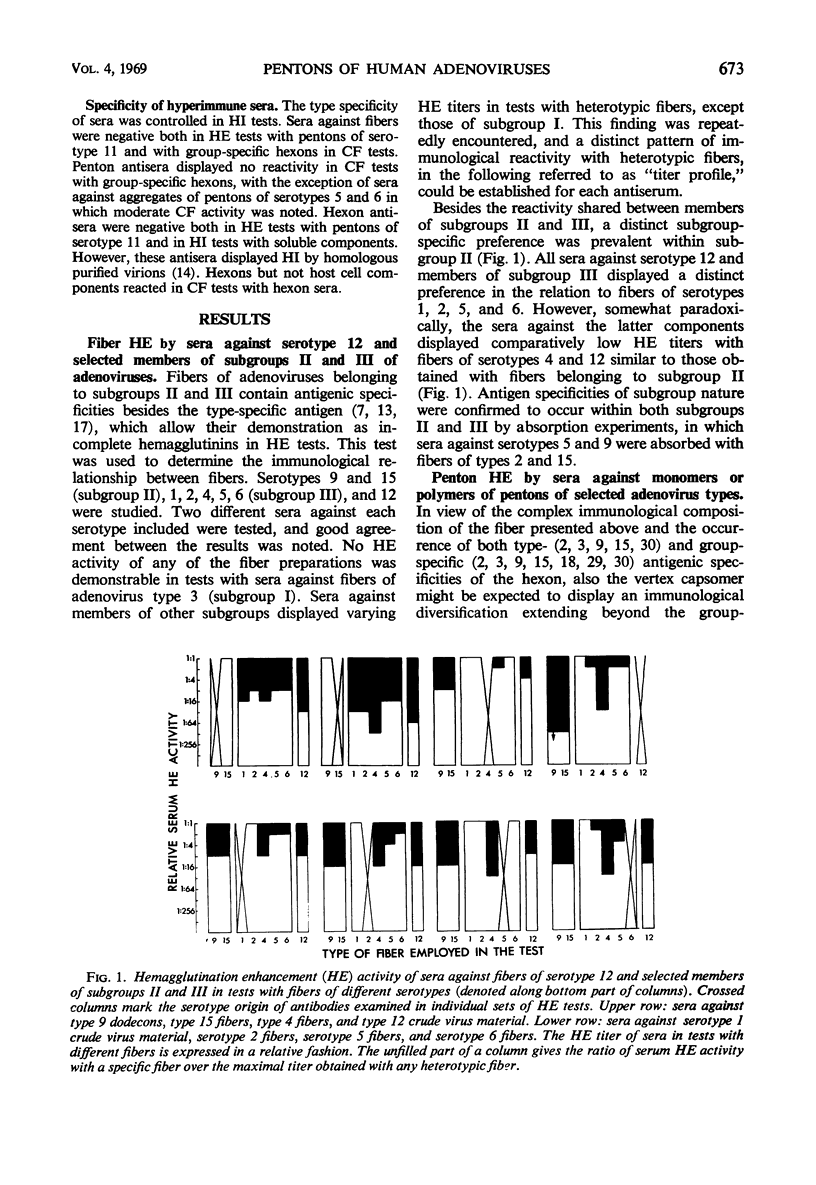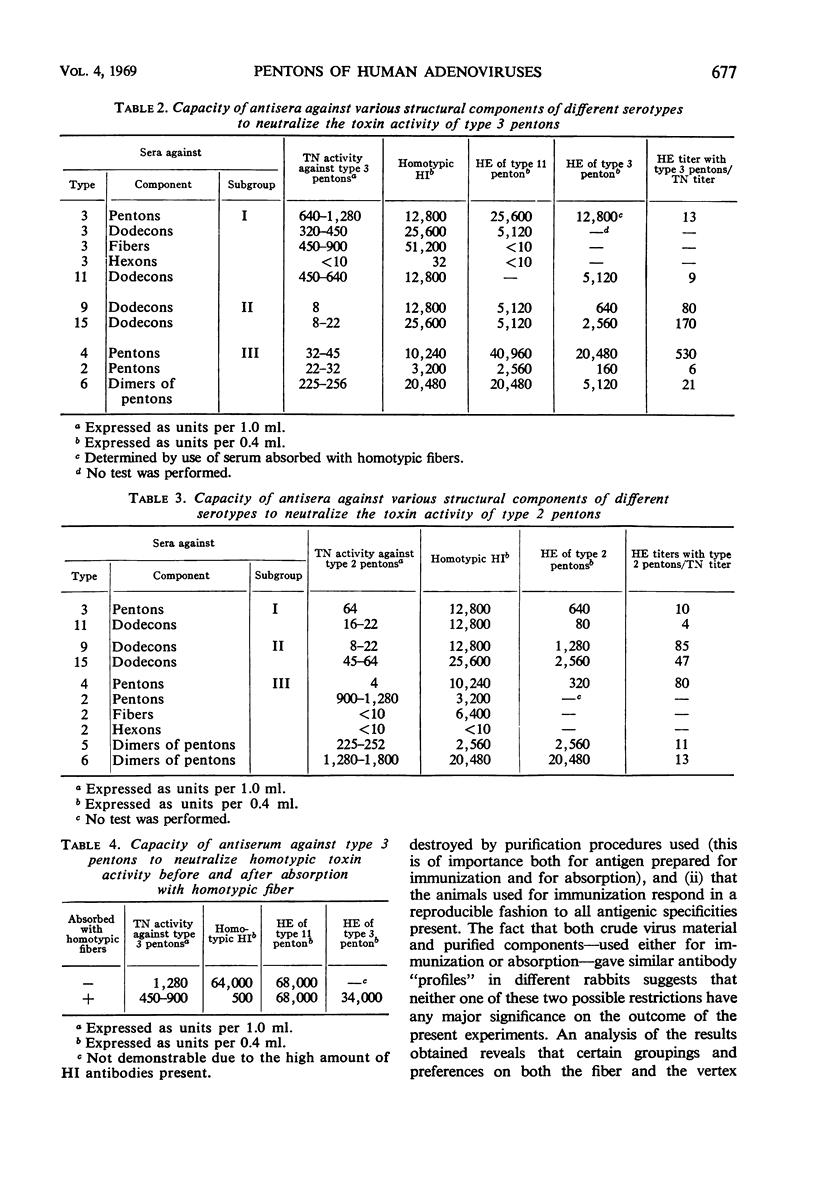Abstract
Comparative hemagglutination-enhancement (HE) tests demonstrated diversified patterns of antigenic specificities both in the fiber and vertex capsomer part of pentons of human adenovirus types 3, 11 (subgroup I), 9, 15 (II), 1, 2, 4, 5, 6 (III), and 12. All fibers contained a type-specific antigen. Subgroup II and III fibers, in addition, contained specificities both unique for each subgroup and also common to the two subgroups. Fibers of serotypes 4 and 12 displayed a somewhat deviating behavior. All vertex capsomers tested shared a group-specific part. This was the only antigenic specificity demonstrable for serotype 12. Maximal penton HE titers of all sera were reached in tests with incomplete hemagglutinin of type 11. In addition, maximal HE activity of sera against individual serotypes also was recorded against pentons of other members of the same subgroup. Antigen characteristics of vertex capsomers of type 4 indicated a closer relationship to subgroup I than to subgroup III. The toxin activity of pentons was more sensitive to trypsin treatment than their capacity to function as incomplete hemagglutinin. Homotypic antipenton sera, unabsorbed or absorbed with homotypic fibers to remove antibodies against this component, and, to a varying extent, also heterotypic antipenton sera could neutralize toxin activity. Antifiber sera could neutralize toxin activity of pentons carrying short fibers (10 nm, type 3) but not of those carrying long fibers (28 to 31 nm, type 2). It is concluded that toxin activity is carried by a specific part of vertex capsomers and that cell detachment can be brought about via a direct contact between this component and cell membranes. Fiber-mediated attachment does not seem to be necessary for this biological activity to become expressed.
Full text
PDF









Selected References
These references are in PubMed. This may not be the complete list of references from this article.
- EVERETT S. F., GINSBERG H. S. A toxin-like material separable from type 5 adenovirus particles. Virology. 1958 Dec;6(3):770–771. doi: 10.1016/0042-6822(58)90123-5. [DOI] [PubMed] [Google Scholar]
- Kjellén L., Pereira H. G. Role of adenovirus antigens in the induction of virus neutralizing antibody. J Gen Virol. 1968 Jan;2(1):177–185. doi: 10.1099/0022-1317-2-1-177. [DOI] [PubMed] [Google Scholar]
- MARRACK J. R. SENSITIVITY AND SPECIFICITY OF METHODS OF DETECTING ANTIBODIES. Br Med Bull. 1963 Sep;19:178–182. doi: 10.1093/oxfordjournals.bmb.a070053. [DOI] [PubMed] [Google Scholar]
- Norby E. Comparative studies on the soluble components of adenovirus types 9 and 15 and the intermediate strain 9-15. J Virol. 1968 Oct;2(10):1200–1210. doi: 10.1128/jvi.2.10.1200-1210.1968. [DOI] [PMC free article] [PubMed] [Google Scholar]
- Norrby E., Ankerst J. Biological characterization of structural components of Adenovirus type 12. J Gen Virol. 1969 Sep;5(2):183–194. doi: 10.1099/0022-1317-5-2-183. [DOI] [PubMed] [Google Scholar]
- Norrby E. Identification of soluble components of adenovirus type 11. J Gen Virol. 1968 Jan;2(1):123–133. doi: 10.1099/0022-1317-2-1-123. [DOI] [PubMed] [Google Scholar]
- Norrby E., Nyberg B., Skaaret P., Lengyel A. Separation and characterization of soluble adenovirus type 9 components. J Virol. 1967 Dec;1(6):1101–1108. doi: 10.1128/jvi.1.6.1101-1108.1967. [DOI] [PMC free article] [PubMed] [Google Scholar]
- Norrby E., Skaaret P. Comparison between soluble components of adenovirus types 3 and 16 and of the intermediate strain 3-16 (the San Carlos agent). Virology. 1968 Oct;36(2):201–211. doi: 10.1016/0042-6822(68)90137-2. [DOI] [PubMed] [Google Scholar]
- Norrby E., Skaaret P. The relationship between soluble antigens and the virion of adenovirus type 3. 3. Immunological identification of fiber antigen and isolated vertex capsomer antigen. Virology. 1967 Jul;32(3):489–502. doi: 10.1016/0042-6822(67)90301-7. [DOI] [PubMed] [Google Scholar]
- Norrby E. The relationship between the soluble antigens and the virion of adenovirus type 3. I. Morphological characteristics. Virology. 1966 Feb;28(2):236–248. doi: 10.1016/0042-6822(66)90148-6. [DOI] [PubMed] [Google Scholar]
- Norrby E. The relationship between the soluble antigens and the virion of adenovirus type 3. II. Identification and characterization of an incomplete hemagglutinin. Virology. 1966 Dec;30(4):608–617. doi: 10.1016/0042-6822(66)90165-6. [DOI] [PubMed] [Google Scholar]
- Norrby E. The relationship between the soluble antigens and the virion of adenovirus type 3. IV. Immunological complexity of soluble components. Virology. 1969 Apr;37(4):565–576. doi: 10.1016/0042-6822(69)90274-8. [DOI] [PubMed] [Google Scholar]
- Norrby E., Wadell G. Immunological relationships between hexons of certain human adenoviruses. J Virol. 1969 Nov;4(5):663–670. doi: 10.1128/jvi.4.5.663-670.1969. [DOI] [PMC free article] [PubMed] [Google Scholar]
- Norrby E., Wadell G., Marusyk H. Fiber-associated incomplete and complete hemagglutinins of adenovirus type 6. Arch Gesamte Virusforsch. 1969;28(2):239–244. doi: 10.1007/BF01249389. [DOI] [PubMed] [Google Scholar]
- Norrby E., Wadell G. Soluble components of adenovirus type 4. Virology. 1967 Apr;31(4):592–600. doi: 10.1016/0042-6822(67)90187-0. [DOI] [PubMed] [Google Scholar]
- PEREIRA H. G. A protein factor responsible for the early cytopathic effect of adenoviruses. Virology. 1958 Dec;6(3):601–611. doi: 10.1016/0042-6822(58)90109-0. [DOI] [PubMed] [Google Scholar]
- PEREIRA H. G., DE FIGUEIREDO M. V. Mechanism of hemagglutination by adenovirus types 1,2,4,5 and 6. Virology. 1962 Sep;18:1–8. doi: 10.1016/0042-6822(62)90171-x. [DOI] [PubMed] [Google Scholar]
- PEREIRA H. G. Typing of adenoidal-pharyngeal-conjunctival (APC) viruses by complement-fixation. J Pathol Bacteriol. 1956 Jul;72(1):105–109. [PubMed] [Google Scholar]
- Pettersson U., Philipson L., Höglund S. Structural proteins of adenoviruses. I. Purification and characterization of the adenovirus type 2 hexon antigen. Virology. 1967 Dec;33(4):575–590. doi: 10.1016/0042-6822(67)90057-8. [DOI] [PubMed] [Google Scholar]
- Pettersson U., Philipson L., Höglund S. Structural proteins of adenoviruses. II. Purification and characterization of the adenovirus type 2 fiber antigen. Virology. 1968 Jun;35(2):204–215. doi: 10.1016/0042-6822(68)90261-4. [DOI] [PubMed] [Google Scholar]
- ROSEN L. A hemagglutination-inhibition technique for typing adenoviruses. Am J Hyg. 1960 Jan;71:120–128. doi: 10.1093/oxfordjournals.aje.a120085. [DOI] [PubMed] [Google Scholar]
- ROWE W. P., HARTLEY J. W., ROIZMAN B., LEVY H. B. Characterization of a factor formed in the course of adenovirus infection of tissue cultures causing detachment of cells from glass. J Exp Med. 1958 Nov 1;108(5):713–729. doi: 10.1084/jem.108.5.713. [DOI] [PMC free article] [PubMed] [Google Scholar]
- Russell W. C., Hayashi K., Sanderson P. J., Pereira H. G. Adenovirus antigens--a study of their properties and sequential development in infection. J Gen Virol. 1967 Oct;1(4):495–507. doi: 10.1099/0022-1317-1-4-495. [DOI] [PubMed] [Google Scholar]
- SIMON M. Haemagglutination experiments with certain adenovirus type strains. Acta Microbiol Acad Sci Hung. 1962;9:45–54. [PubMed] [Google Scholar]
- Schlesinger R. W. Adenoviruses: the nature of the virion and of controlling factors in productive or abortive infection and tumorigenesis. Adv Virus Res. 1969;14:1–61. doi: 10.1016/s0065-3527(08)60556-4. [DOI] [PubMed] [Google Scholar]
- Valentine R. C., Pereira H. G. Antigens and structure of the adenovirus. J Mol Biol. 1965 Aug;13(1):13–20. doi: 10.1016/s0022-2836(65)80076-6. [DOI] [PubMed] [Google Scholar]
- WILCOX W. C., GINSBERG H. S. PRODUCTION OF SPECIFIC NEUTRALIZING ANTIBODY WITH SOLUBLE ANTIGENS OF TYPE 5 ADENOVIRUS. Proc Soc Exp Biol Med. 1963 Oct;114:37–42. doi: 10.3181/00379727-114-28579. [DOI] [PubMed] [Google Scholar]
- Wadell G. Hemagglutination with adenovirus serotypes belonging to Rosen's subgroups II and 3. Proc Soc Exp Biol Med. 1969 Nov;132(2):413–421. doi: 10.3181/00379727-132-34227. [DOI] [PubMed] [Google Scholar]
- Wadell G., Norrby E., Schönning U. Ultrastructure of soluble antigens and the virion of adenovirus type 4. Arch Gesamte Virusforsch. 1967;21(2):234–242. doi: 10.1007/BF01241447. [DOI] [PubMed] [Google Scholar]
- Wadell G., Norrby E., Skaaret P. The soluble hemagglutinins of adenoviruses belonging to Rosen's subgroup 3. I. The rapidly sedimenting hemagglutinin. Arch Gesamte Virusforsch. 1969;26(1):33–52. doi: 10.1007/BF01241174. [DOI] [PubMed] [Google Scholar]
- Wadell G., Norrby E. The soluble hemagglutinins of adenoviruses belonging to Rosen's subgroup 3. II. The slowly sedimenting hemagglutinin. Arch Gesamte Virusforsch. 1969;26(1):53–62. doi: 10.1007/BF01241175. [DOI] [PubMed] [Google Scholar]
- Wadell G., Skaaret P. Separation of adenovirus type 4 components. Arch Gesamte Virusforsch. 1967;21(3):366–382. doi: 10.1007/BF01241737. [DOI] [PubMed] [Google Scholar]


